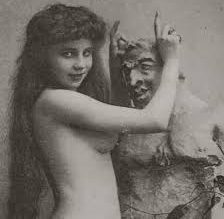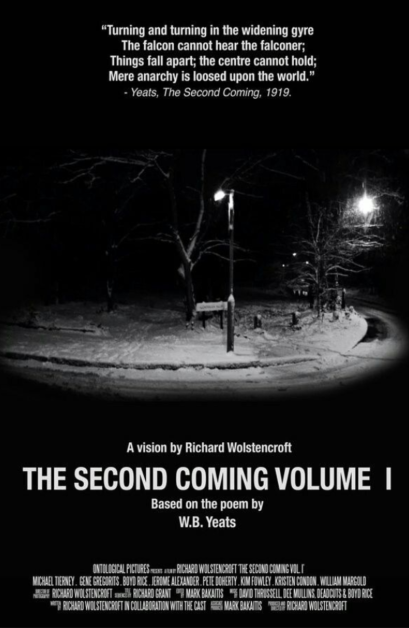There’s a dearth of films that deal with the occult in a serious or informed manner, hence my excitement when I became aware that a new film by Australian director Richard Wolstencroft entitled The Second Coming Vol. 1 and described by him as both a “vision” and a “cinematic invocation of the apocalypse” had entered post-production. I initially discovered Wolstencroft through his 1999 film Pearls Before Swine, which plays like a heady blend of Kubrick and David Mamet by way of Martin Heidegger. Billed by Wolstencroft as an ode to “transcendental fascism” and starring underground noise musician and provocateur Boyd Rice, Pearls juxtaposes scenes of brutal violence with profound philosophical exposition and a twisted sense of humor. One critic described the film as “A Clockwork Orange for the new millennium.” Due to its controversial nature, Pearls Before Swine failed to gain acceptance into the Melbourne International Film Festival; undeterred, Wolstencroft founded his own Melbourne Underground Film Festival, or MUFF, at which to screen the film and others of its kind in the year 2000. The festival continues to this day, and was a primary inspiration for myself and one of my film school classmates to found our own Detroit Underground Film Festival in 2012, which was unfortunately discontinued after its sophomore year in 2013. We rounded out the third night of the 2012 DUFF with a Wolstencroft double feature, screening both Pearls Before Swine and the director’s 2010 film adaptation of the F. Scott Fitzgerald novel The Beautiful and Damned, which Wolstencroft dedicated to author Bret Easton Ellis. Both films were well-received by our audience. The Second Coming Vol. 1 comes on the heels of Wolstencroft’s 2013 documentary The Last Days Of Joe Blow, which explores the life and work of Michael Tierney (nephew of the eccentric character actor Lawrence Tierney, the latter most commonly known for having played Joe in Reservoir Dogs and Elaine’s dad in Seinfeld), an actor who enters and eventually leaves the porn industry, using the alias “Joe Blow.” Tierney is also featured prominently in The Second Coming Vol. 1, which I will now get down to the business of reviewing.
The film is based on and named after the poem “The Second Coming” by Irish mystical poet William Butler Yeats. Indeed, Wolstencroft goes as far as to describe the work as a collaboration between himself and the long-deceased poet. Individual lines of the poem are interspersed throughout the title sequence (featuring archival footage of warfare, natural disasters, and other assorted forms of destruction) and used to divide the three sections of the film. Widely considered to be one of the best poets of the twentieth century, Yeats is a perfect subject for Wolstencroft given the former’s involvement with the occult (at one point he was a member of The Hermetic Order Of The Golden Dawn, alongside magicians such as Aleister Crowley and Arthur Edward Waite) and fascism (Yeats was affiliated with the Irish Blueshirts). Certain characters in The Second Coming are based on those from Yeats’ poetry, such as Michael Robartes and Owen Aherne, both of whom frequently appear throughout his oeuvre.
Part one of the film begins with the Michael Robartes character (played by the above-mentioned Michael Tierney aka Joe Blow) wandering through a barren landscape, along train tracks, and attempting to hitchhike. Frustrated, he calls out to God asking for a sign, immediately after which he stumbles upon a drain that he interprets as a magick circle. He then sets up a miniature baphomet statue and reads a passage from the book 777 by Aleister Crowley, thereby performing a ritual invocation of the baphomet to bring on the second coming. Robartes is then seen exploring the city of Bangkok in Thailand and engaging in sexual escapades (likely of the magickal variety given the character’s actions up to this point) with the local prostitutes. He meets with a shady gentleman who sells him various occult artifacts, including the baphomet statue that he had used in the aforementioned ritual, suggesting that the narrative has gone backwards in time. All of this footage was shot on location, and the multitude of exotic locations in the film, from the legendary Hanging Rock in Australia to Thailand to Denver, Colorado and Los Angeles, lend it a sense of breadth and expansiveness. It is here in Thailand that the Owen Aherne character (played by Wolstencroft, performing under his alias “Richard Masters”), a clearly malicious entity, is first introduced. Aherne meets with Robartes and informs him that he is aware of the latter’s intention to perform the “777 ritual” that will bring forth the second coming. After a brief interlude in which a young woman (played by up and coming Australian film actress Kristen Condon) wanders around Hanging Rock in Victoria, Australia (a landmark brimming with mythology), appearing to be in a sort of trance state, part two commences.
The narrative shifts perspective as Robartes meets up with Gene Ferry (the controversial novelist Gene Gregorits is essentially playing himself in this role) in Los Angeles. Gene is the protagonist of the second act, and his first order of business is to visit his father (played by porn industry legend William Margold) and propose his theory that Charles Manson put a black curse on mankind through the murders committed by his followers in 1969. A whole assortment of underground counterculture icons hover within Gene’s orbit, among them actress and singer Giddle Partridge, documentary filmmaker Larry Wessel (who hilariously mocks Gene’s novel Dog Days by referring to it as “dog balls”), and the now deceased punk rock legend Kim Fowley in what is his last appearance on film. Gene’s “research” (which consists largely of drinking copious amounts of alcohol and doing cocaine) culminates in a visit to Spahn Ranch, the former home of Charles Manson and his “family”, facilitated by Owen Aherne, leading to a startling and haunting ending that would be a crime to spoil here and marking the beginning of part three.
Boyd Rice, the aforementioned industrial music pioneer, social Darwinist, and occult researcher appears in what is my favorite sequence of the film, playing a role that is, at least spiritually, a continuation of his character from Wolstencroft’s Pearls Before Swine. In The Second Coming Boyd’s character is named Bill Cuchulainn and is a Dick Cheney-esque political villain; Robartes and Aherne are both in his employ. The sequence begins with several beautiful shots of Boyd and his wife Karen Buchbinder walking around snow-covered Denver, Colorado, both clad in militaristic black clothing as martial drums pound in the background. Boyd recites some of his own free-verse poetry before engaging in an insightful discussion of United States politics with Aherne. He then takes a call in which he orders a bombing, hilariously clarifying to his underling that he doesn’t care if he hits “a mosque, a McDonalds, or The Southern Poverty Law Center.”
After a series of ominous shots outside of the European Organization for Nuclear Research, the third and final protagonist (played by occultist and musician Jerome Alexandre of the band Deadcuts) appears, performing a ritual with his partner (played by English music journalist Nina Antonia), surrounded by the writings of Church of Satan founder Anton LaVey. The two of them proceed to study dark energy and other topics relating to quantum physics while discussing their respective experiences with the supernatural. The centerpiece of this act is an improvised jam session between Jerome and troubled British musician Pete Doherty, best known as the frontman of the bands The Libertines and Babyshambles and a former lover of model Kate Moss.
The Second Coming Vol. 1 is bursting at the seams with icons of the counterculture and underground. As you can see, much of my review consists of identifying the actors employed. For those that recognize the players involved, or are interested in discovering some truly unique artists and thinkers that reside outside of the mainstream, the film is a gift that keeps on giving, and this is not to mention the wealth of occult secrets contained within. Having come together over the course of five years, the passion, dedicated and thorough research (Wolstencroft provides a bibliography of books related to Yeats that he consulted while developing the film in the credits), and genuine occult experimentation that went into the production shine through luminously, creating a hypnotic and emotionally resonant effect for the viewer. Drawing on the tradition of cinema vérité while at the same time employing his own unique style, Wolstencroft has crafted a contemporary epic that will come as a breath of fresh air to those who are looking for something dark, unorthodox, and legitimately new.
The Second Coming Vol. 1 is currently playing festivals. A dvd will be released in 2017, along with The Second Coming Vol. 2, which will expand upon the narrative threads introduced in this initial volume.
TO THE NEW DAWN!




